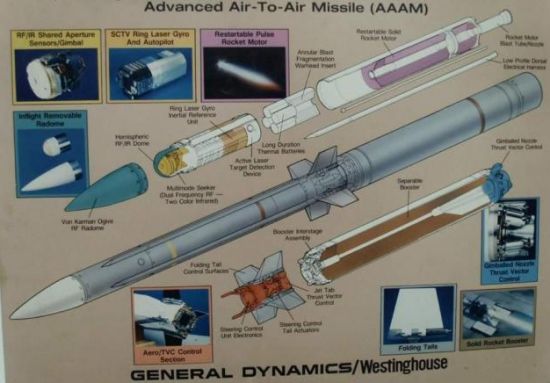|
||||||||||
|
|
||||||||||
|
||||||||||
|
|
||||||||||
However, it is interesting to note that the Navy did have a project to develop a replacement for the Phoenix underway during the late 1980s. Known as the Advanced Air-to-Air Missile, or AAAM (pronounced triple-a-m), the goal was to develop a much smaller and lighter missile with greater range at a speed of at least Mach 3. AAAM was to incorporate a number of advanced technologies that had been evaluated during development of the Advanced Common Intercept Missile Demonstration (ACIMD, pronounced a-sim-d) vehicle at the US Naval Weapons Center at China Lake, California. Among these new technologies were advanced multimode-guidance, an air-breathing integral-rocket-ramjet propulsion system, new warhead and fuzing designs, and advanced airframe and steering technologies. ACIMD was developed at China Lake during the early 1980s and several test examples were built, but the project was cancelled before it could be flown.

Nevertheless, the AAAM project proceeded under the designation AIM-152. In 1987, two teams consisting of Hughes and Raytheon as well as General Dynamics and Westinghouse were selected to develop concepts to meet the AAAM mission. The Hughes/Raytheon proposal, shown below, bore a strong resemblance to ACIMD, using a hybrid solid-rocket/ramjet propulsion system that offered higher speeds at maximum range. Mid-course guidance was to be inertial with command updates while a dual-mode active-radar and infrared seeker would provide terminal homing.

General Dynamics and Westinghouse offered a much different solution, however, with a significantly smaller design. Propulsion was to be supplied by a multiple-pulse solid-propellant rocket motor with a booster stage that would be dropped during flyout. The concept also employed inertial guidance with dual-band semi-active radar homing for mid-course guidance and an electro-optical sensor for autonomous homing during the terminal end-game. GD also proposed a backup infrared seeker should the electro-optical seeker fail. Another unique idea was fitting the launch aircraft with a targeting pod featuring forward- and aft-looking radar to illuminate the target from any angle.

It was envisioned that AAAM would enter service from the mid-1990s replacing the expensive, aging, high-maintenance AIM-54 Phoenix. However, the end of the Cold War, the perceived lack of a mission requiring such a long-range missile, and cuts in defense spending led Congress to cancel the project in 1992.
But despite the upcoming retirement of the Phoenix, the outer-air battle capability will not be completely lost.
In the short term, the Navy plans to purchase an upgraded version of the AIM-120C AMRAAM with an increased range of
over 40 nm (75 km). Even further into the future, the Navy is looking to develop a so-called Dual Range
Missile that will replace not only AMRAAM but also the short-range AIM-9 Sidewinder. The goal of this effort is to
replace all existing Navy air-to-air missiles with a single weapon. This new missile would have double the range
of AMRAAM and twice the short-range performance of AIM-9X. However, developing a single missile that can achieve
both long range and short-range manueverability simultaneously will be quite a challenge. Great advancements in
propulsion, sensors, aerodynamics, and flight control technologies will be required to meet these performance goals.
- answer by Jeff Scott, 18 May 2003
Related Topics:
I want to know more about the F-14 replacement. I saw a picture of a swing wing F-22.
I would like to know about the F-14A Tomcat used by Iran.
Read More Articles:


|
Aircraft | Design | Ask Us | Shop | Search |

|
|
| About Us | Contact Us | Copyright © 1997- | |||
|
|
|||